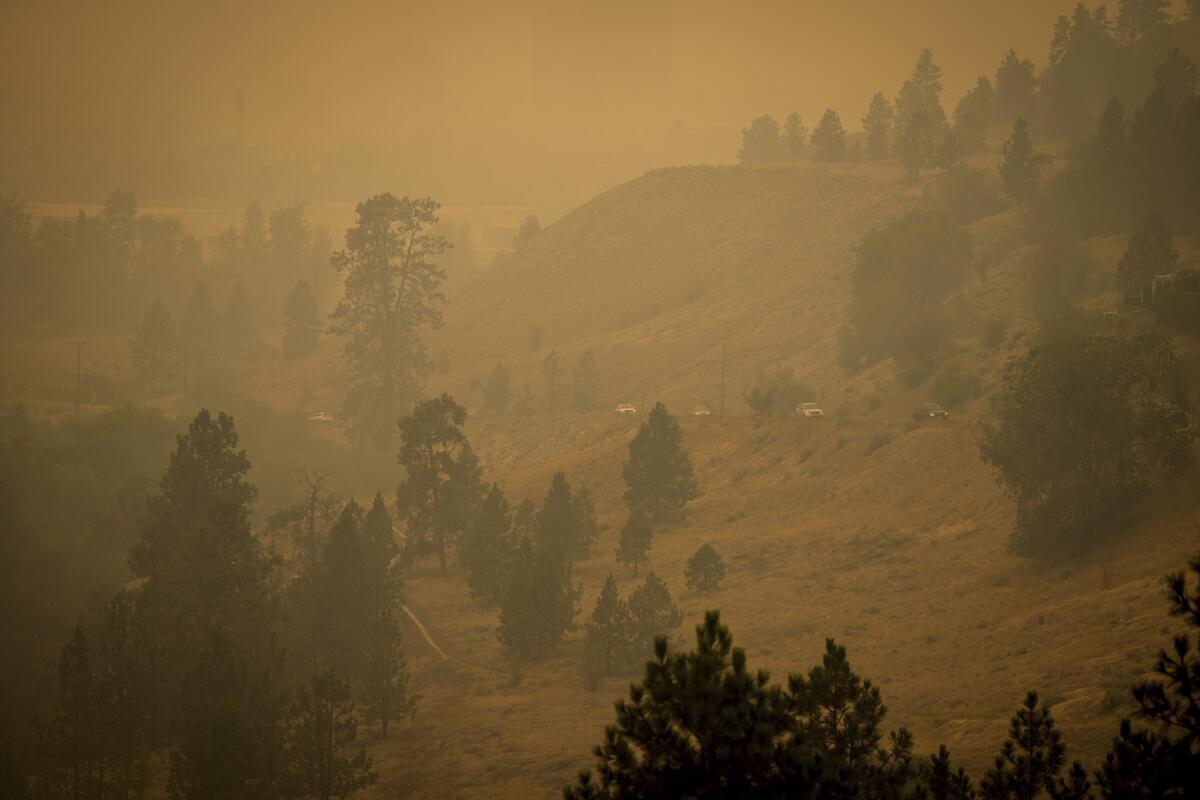Fires threatening two cities in western Canada under control but residents ‘not out of woods’

- Share via
VANCOUVER — Firefighters kept wildfires at bay near the capital of Canada’s Northwest Territories as well as a threatened city in British Columbia, though no one claimed victory as forecasters warned that drier and windier weather was coming.
Milder weather was forecast to end Sunday, after providing some help for fire teams battling to contain the flames of Canada’s worst fire season on record that has destroyed homes and other buildings, fouled the air with thick smoke and prompted evacuation orders for tens of thousands of residents.
Officials said Saturday that a huge wildfire had been kept from advancing closer than nine miles to Yellowknife, the capital of the Northwest Territories that was left virtually empty when nearly all of its 20,000 residents fled for safety.
“We’re by no means out of the woods yet,” Mike Westwick, wildfire information officer for the city, told the Associated Press. “We still have a serious situation. It’s not safe to return.”
To the south, in British Columbia, raging flames were also kept away from Kelowna, a city of some 150,000 people about 90 miles north of the United States border.
The Kelowna fire is among more than 380 blazes across the province, with 150 burning out of control. The blaze near Yellowknife is one of 237 wildfires burning in the Northwest Territories.
The break that firefighters defending Yellowknife got from milder weather and a small amount of rain was expected to end, as temperatures were forecast to climb higher Sunday.
Firefighters were planning to scan the fires with infrared sensors to better understand their condition and judge whether an attack on them would be safe and successful.
Shane Thompson, the minister of environment and climate change for the Northwest Territories, said the fires near Yellowknife had not grown very much in the last few days, thanks to breaks in the weather.
“But I want to be clear, a little bit of rain doesn’t mean it’s safe to come back home,” he said at a news conference late Saturday. Others warned that incoming hot weather would make the battle more challenging.
Yellowknife Mayor Rebecca Alty urged residents to stay away to ensure their safety and help with firefighting efforts. She said patrols were monitoring streets and homes to protect against looting.
The city has become a virtual ghost town since residents fled following an evacuation order issued Wednesday evening. Long lines of cars choked the main highway and people lined up for emergency flights. The last 39 hospital patients were flown out Friday night on a Canadian Armed Forces plane, officials said. About 2,600 people remained in town, including emergency teams, firefighters, utility workers and police officers, along with some residents who refused to leave.
Charlotte Morritt and her 4-month-old son took an evacuation flight Thursday some 1,500 kilometers (950 miles) west to safety in Whitehorse, Yukon, while her partner stayed behind to monitor their property and help create firebreaks and fight fires.
“We knew it was only a matter of time,” said Morritt, a journalist with the Aboriginal Peoples Television Network.
Air tankers dropped water and fire retardant to keep the flames from Yellowknife. A six-mile fire line was dug, and firefighters deployed 12 miles of hose and a plethora of pumps.
Canada has seen a record number of wildfires this year that have caused choking smoke in parts of the U.S. All told, there have been more than 5,700 fires, which have burned more than 53,000 square miles from one end of Canada to the other, according to the Canadian Interagency Forest Fire Center.
All of British Columbia was under a state of emergency. About 35,000 people had been ordered to evacuate wildfire zones across the province and an additional 30,000 people were under an evacuation alert, meaning they should be prepared to leave, Premier David Eby said.
The “situation changes very quickly,” he said, adding that he was restricting nonessential travel to fire-affected areas to free up accommodations such as hotels, motels and campgrounds for displaced residents and firefighters.
Todd Ramsay recalled sitting on his deck Thursday night at his family’s home in Kelowna’s North Clifton area, watching the fire rage on the other side of Lake Okanagan, about 1.5 miles away. He didn’t think it would be possible for the flames to jump the lake, but they did.
“Sure enough, it started raining pine cones and tree bark,” he said. A fire quickly started behind his house and there were “huge plumes of smoke just carrying embers across the lake.” Ramsay said he turned on a water sprinkler and he and his family packed up to flee as trees were burning, wondering if they’d see their home again.
By Saturday, Ramsay, his wife, two children, two cats and a dog had driven to North Vancouver to stay with his sister. Ramsay heard his house had not burned but didn’t know for sure.
“There’s definitely some anxiety around it. Where we’re going to stay, what we’re going to do when we get back, if it’s not there,” he said. “I’m an artist. I have a lot of my paints there. The more important thing obviously is all of us are safe. But we’ve worked hard our whole lives to have this home.”
Ian Stewart and his wife made the “anxiety-producing” decision Friday to evacuate Kelowna with their 4-year-old border collie and drive 210 miles to the British Columbia town of Clearwater.
“The smoke was really oppressive and there were big chunks of ash falling everywhere,” he said. They packed a couple of suitcases, passports, laptop computers and dog food, and drove in bumper-to-bumper traffic to escape.
More to Read
Sign up for Essential California
The most important California stories and recommendations in your inbox every morning.
You may occasionally receive promotional content from the Los Angeles Times.












